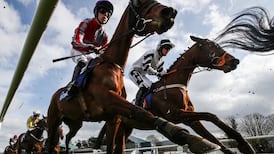In 2019, before the Covid-19 pandemic, attendance levels at Irish racecourses officially reached just over 1.3 million. It put racing second only to Gaelic games in total attendees, a point underlined by officials. But how accurate are such statistics in terms of racing’s actual spectator appeal?
Last year figures emerged that more than half the people going greyhound racing were owners, trainers, bookies or had complimentary tickets of some sort. Strictly speaking they were in attendance. But attending and spectating aren’t synonymous.
Such a distinction resonates in the horse game too. There is no precise breakdown of attendance figures due to “commercial sensitivities”. But popular scepticism is that every set of legs at a race meeting get counted, including the starter’s dog.
The better the figures, the better the pitch racing generally can make in relation to areas like sponsorship. And the sport’s underlying popularity is obvious when it comes to major festivals like Punchestown and Galway.
READ MORE
But to regular racegoers an official average attendance figure of 3,621 at Irish race meetings in 2019 looks an optimistic interpretation of the reality at many fixtures, where fans paying in can appear outnumbered by those with a reason to be there.
That doesn’t reflect a lack of interest. The old game’s attraction is stamped all over viewing figures on TV, online and streaming with a consequent profitable pay-off for Ireland’s 26 racecourses.
Media rights deals mean even the most ordinary race can be worth up to €8,000 to a track, something that perhaps explains the proliferation of eight-race fixtures. Top class meetings with Group/Grade One races can generate six figures in a single day.
Such a commercial reality makes gate revenue largely irrelevant to most tracks since charging people at the turnstile pales in financial comparison to the wealth generated by media rights.
That revenue stream allowed most courses survive the pandemic relatively unscathed. The atmosphere on the ground was hollow but the concept of racetracks as huge open-air TV studios remained an irresistible private enterprise proposition.
That has continued since, and it means an official 10 per cent dip in attendance levels for the first half of last year had little bottom-line impact. It is likely to remain the case when Horse Racing Ireland’s statistics for all of 2022 get released next week.
It allows Irish racing to pay little more than lip-service to growing attendances. But shrugging shoulders at a lack of boots on the ground will eventually prove costly because rare is the sport able to get away with ignoring the importance of its spectator appeal.
English soccer’s TV reach doesn’t prevent full houses. Significant crowds turn out here for GAA and rugby games, still prepared to pay to watch live action first-hand. Yet figures in Britain last week showed a 14 per cent slide in racing attendances there in 2022 compared to 2019.
Just because racing can afford such dips doesn’t mean there’s no cost. It may be intangible in accounting terms but could prove very pricey indeed for the sport’s long-term prestige, profile, and popular relevance.
Without public engagement you get racing as it largely is in France and North America; deserted tracks producing betting fodder for markets where racing is little more than another gambling medium. The result is that the sport’s wider public visibility there has fallen off a cliff.
The great rider Olivier Peslier memorably said: “If I tell someone in France I am a jockey they think I mean a DJ.”
Contrast that with jurisdictions such as Australia, Japan and Hong Kong, where racing has a popular reach that regularly sees massive attendances of actual spectators actually interested in the sport.
Irish racing has always prided itself on a similar connection, confident enough to condescend to US racing’s more casino-like atmosphere. But the pandemic brought an uncomfortable glimpse of the dangers of taking that connection for granted.
Because a sport that starts to lose its spectator appeal can quickly find itself flirting with the greatest threat of all – irrelevance. That means the cost of encouraging people through the gates should be viewed as an investment rather than a cost.
How best to effectively do that is a single big question probably best addressed with many little steps.
With so much TV money in the system just one could be picking up the cost of reduced admission prices. Expecting people to pay €20 to get into an everyday, midweek fixture is expecting way too much.
And having got them in there’s no excuse for not catering to them as valued guests rather than largely superfluous add-ons to the extent of encouraging them to come back again, maybe accompanied by others.
By which time a more transparent system of calculating crowd figures might even be in place, possibly such an old-fashioned gauge as totting up actual gate revenue.
Something for the weekend
Just a head separated MAHLER MISSION from Shantreusse when they filled the frame behind Must Be Obeyed on New Year’s Eve. Both are strong stayers, as well as being ground versatile, and can battle it out again in Navan’s 2.52pm race on Saturday.
FRENCH DYNAMITE has run five times at Thurles and won on four occasions. Mouse Morris’s charge didn’t look to stay three miles behind Conflated at Christmas and drops in trip for Sunday’s big chase. He faces a potential big task on ratings, but this Grade Two prize could prove his ideal set-up.


















